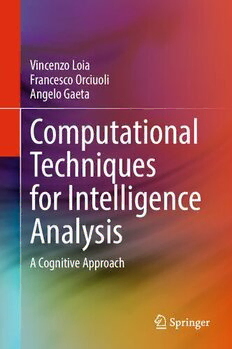Table Of ContentVincenzo Loia
Francesco Orciuoli
Angelo Gaeta
Computational
Techniques
for Intelligence
Analysis
A Cognitive Approach
Computational Techniques for Intelligence Analysis
· ·
Vincenzo Loia Francesco Orciuoli Angelo Gaeta
Computational Techniques
for Intelligence Analysis
A Cognitive Approach
VincenzoLoia FrancescoOrciuoli
DipartimentodiScienze DipartimentodiScienze
Aziendali—Management&Innovation Aziendali—Management&Innovation
Systems(DISA-MIS) Systems(DISA-MIS)
UniversitàdegliStudidiSalerno UniversitàdegliStudidiSalerno
Fisciano,Salerno,Italy Fisciano,Salerno,Italy
AngeloGaeta
DipartimentodiScienze
Aziendali—Management&Innovation
Systems(DISA-MIS)
UniversitàdegliStudidiSalerno
Fisciano,Salerno,Italy
ISBN 978-3-031-20850-8 ISBN 978-3-031-20851-5 (eBook)
https://doi.org/10.1007/978-3-031-20851-5
©TheEditor(s)(ifapplicable)andTheAuthor(s),underexclusivelicensetoSpringerNature
SwitzerlandAG2023
Thisworkissubjecttocopyright.AllrightsaresolelyandexclusivelylicensedbythePublisher,whether
thewholeorpartofthematerialisconcerned,specificallytherightsoftranslation,reprinting,reuse
ofillustrations,recitation,broadcasting,reproductiononmicrofilmsorinanyotherphysicalway,and
transmissionorinformationstorageandretrieval,electronicadaptation,computersoftware,orbysimilar
ordissimilarmethodologynowknownorhereafterdeveloped.
Theuseofgeneraldescriptivenames,registerednames,trademarks,servicemarks,etc.inthispublication
doesnotimply,evenintheabsenceofaspecificstatement,thatsuchnamesareexemptfromtherelevant
protectivelawsandregulationsandthereforefreeforgeneraluse.
Thepublisher,theauthors,andtheeditorsaresafetoassumethattheadviceandinformationinthisbook
arebelievedtobetrueandaccurateatthedateofpublication.Neitherthepublishernortheauthorsor
theeditorsgiveawarranty,expressedorimplied,withrespecttothematerialcontainedhereinorforany
errorsoromissionsthatmayhavebeenmade.Thepublisherremainsneutralwithregardtojurisdictional
claimsinpublishedmapsandinstitutionalaffiliations.
ThisSpringerimprintispublishedbytheregisteredcompanySpringerNatureSwitzerlandAG
Theregisteredcompanyaddressis:Gewerbestrasse11,6330Cham,Switzerland
Preface
ThisbookisaboutComputationalTechniquesforIntelligenceAnalysisthatbelongs
tothemacro-areaofriskmanagement.Riskmanagementistheprocessfocusedon
identification,measurement,assessment,andprocessingofriskswithinanorgani-
zationandshouldallowtherightbalancebetweenthecostsofprotectionmeasures
andtheirbenefitsforsuchorganization.Insuchacontext,intelligenceisthephaseof
riskmanagementdealingwiththepredictionofanomalous(malicious,harmful,etc.)
eventsinsomespecificdomains:security,safety,emergency,surveillance,infrastruc-
ture resilience, etc. Terrorist attacks, cyber-attacks, plane crashes, accident at sea,
fakenewsdiffusion,andspreadofpandemicareallexamplesofeventsthatcanbe
consideredbyintelligenceanalysis.
In particular, the commitment of intelligence is multiple: determining critical
assets,identifyingandevaluatingexistingcountermeasures,definingpossiblethreats,
determining system vulnerabilities, and defining potential losses in the case of a
probableanomalousevent.Fromtheinformationprocessingviewpoint,intelligence
includesmethodologies,activities,andtoolsaimedatobtainingcomplex(oftenstruc-
tured)informationfromasetofisolateddata(oftenrawdata)gatheredfromanindi-
vidual sensor or a sensor system. Such information is used to increase knowledge
andawarenessofsituationsoccurringinagivenscenario.
DespitenumerousexistingmethodologiesandpracticessupportingIntelligence
analysis, this book focuses on the definition and implementation of computational
tools,mostly data driven, supporting decision-making processes along several and
heterogeneousintelligencescenarios.Inparticular,theaforementionedtoolsaimat
increasingthelevelofsituationawarenessofdecision-makersthroughtheconstruc-
tion of abstract structures on which it is possible to reason in order to foster the
chanceofthehumanoperatortomakequalitativedecisions.
This book will appeal to students, professional, and academic researchers in
computational intelligence and approximate reasoning applications for decision-
making in intelligence analysis. It is a comprehensive textbook on the subject,
supportedwithlotsofcasestudiesandpracticalexamples.
Thereaderswillunderstandhowtofacethedefinitionofdecisionsupportsystems
fortheintelligenceanalysisthroughtheconcreteapplicationoftheEndsley’sModel
v
vi Preface
of Situation Awareness and the well-known paradigm of granular computing for
informationprocessing.Theauthorsshowhowtobuildtheaforementionedsystems
byadoptingacognitiveapproach,i.e.,definingcomputationalsolutionsreplicating
humanwaysofproblemsolving.Thedidacticapproachofthebookismainlybased
on case study analysis that is conducted through the definition of a clear solution
methodology, based on cutting-edge computational methods and techniques, and
a practical implementation using Python code. In this way, the reader will get the
solutionapproachaswellastherelatedimplementationissues.
Definitely, the book emphasizes practical applications and computational
methods, which are very useful and important both for reducing the cybersecurity
skillsshortageandforthefurtherdevelopmentofthefieldofintelligenceanalysis.
Focusing on rough set and fuzzy logic theories, three-way decision models, and
different reasoning methods, the authors have built and adopt a didactic approach
that allows to deep analyze and understand problems and computational solutions
and try these solutions with the support of hands-on laboratory based on Python
code.
According to the content structure, the book focuses the first chapters on the
concepts of situation awareness and decision-making in intelligence analysis and
on a clear background on the main theoretical computational methods which are
used. Next, it moves clearly and efficiently from concepts and paradigms to case
studies,methodologies,andimplementation.Thebookendswiththedescriptionofa
technologicalframeworkforthereal-worldimplementationanddeployoftechniques
andmethodsdescribedinthevariouschapters.
Fisciano(SA),Italy VincenzoLoia
June2022 FrancescoOrciuoli
AngeloGaeta
Contents
PartI Foundations
1 Introduction .................................................. 3
1.1 BookContentStructure ................................... 3
1.2 DidacticAspects ......................................... 4
1.3 UsingPythonandGoogleColaboratory ..................... 7
1.4 UsefulResources ......................................... 10
2 IntelligenceAnalysis ........................................... 13
2.1 LearningObjectivesoftheChapter ......................... 13
2.2 TopicMapoftheChapter ................................. 14
2.3 WhatIsIntelligenceAnalysis? ............................. 14
2.4 TheIntelligenceProcess ................................... 17
2.5 TheAnalysisProcessandAnalyticTradecraft ................ 18
2.5.1 FamiliesofSAT ................................... 20
2.5.2 Adoption of SAT in the Intelligence Analysis
Process ........................................... 23
2.5.3 CognitiveandPerceptualBiases ..................... 24
2.6 SomeChallengesofIntelligenceAnalysis ................... 25
3 FoundationsoftheComputationalTechniques ................... 27
3.1 LearningObjectivesoftheChapter ......................... 27
3.2 TopicMapoftheChapter ................................. 28
3.3 SituationAwareness ...................................... 28
3.3.1 SADemons ....................................... 31
3.3.2 InformationProcessingforSA ....................... 33
3.3.3 Goal-DirectedTaskAnalysis ........................ 34
3.3.4 RepresentingOperationalSituations .................. 38
3.4 GranularComputing ...................................... 38
3.5 DealingwithImpreciseandUncertainInformation ............ 40
3.5.1 RoughSetTheory ................................. 41
3.5.2 FuzzySetTheory .................................. 43
vii
viii Contents
3.6 Three-WayDecisions ..................................... 45
3.6.1 SettingThresholdsin3WD .......................... 48
3.7 Hands-onLab ........................................... 50
3.7.1 BasicSourceCode ................................. 50
3.7.2 ProbabilisticandTraditionalRoughSets .............. 56
3.7.3 Three-WayDecisions ............................... 61
3.7.4 FuzzySetsandFuzzyRelations ...................... 64
3.7.5 UsefulResources .................................. 68
4 ApplyingSituationAwarenesstoIntelligenceAnalysis ............ 71
4.1 LearningObjectivesofthisChapter ......................... 71
4.2 TopicMapoftheChapter ................................. 72
4.3 InformationProcessing:OverallFramework .................. 72
4.4 MappingintoIntelligenceCycles ........................... 74
4.5 SelectionandAdoptionofConcreteTechniques .............. 75
PartII ComputationalTechniques
5 DecisionMakingThroughWhat-IfAnalysis ..................... 81
5.1 LearningObjectivesoftheChapter ......................... 81
5.2 TopicMapoftheChapter ................................. 82
5.3 CaseIntroduction:VesselSurveillance ...................... 83
5.4 Methodology ............................................ 84
5.5 ComputationalTechniques ................................. 86
5.5.1 LatticeDerivationwithProbabilisticRoughSets ....... 86
5.5.2 MeasuresforSituationEvolution ..................... 88
5.5.3 Reasoningwith3WDonTemporalStructures .......... 88
5.6 AnalyticalValue ......................................... 90
5.7 Hands-onLab ........................................... 90
5.7.1 LatticeBuilding ................................... 93
5.7.2 AssessingtheSituationEvolution .................... 94
5.8 UsefulResources ......................................... 96
6 SystemModellingwithGraphs ................................. 97
6.1 LearningObjectivesoftheChapter ......................... 97
6.2 TopicMapoftheChapter ................................. 98
6.3 CaseIntroduction:EvaluationofCriticalNodesinaCritical
Infrastructure ............................................ 99
6.4 Methodology ............................................ 100
6.5 ComputationalTechniques ................................. 101
6.5.1 3WDSupportedbyNetworkAnalysis ................ 101
6.5.2 ReasoningonGraphswithGrC ...................... 102
6.6 AnalyticalValue ......................................... 104
6.7 Hands-onLab ........................................... 105
6.7.1 Dataset ........................................... 105
6.7.2 BuildingtheGraph ................................. 105
Contents ix
6.7.3 CalculatingT Values ............................... 107
6.7.4 BuildingtheDecisionTable ......................... 109
6.7.5 Applying3WD .................................... 110
6.7.6 ImplementingaResilienceModel .................... 112
6.8 UsefulResources ......................................... 115
7 BehaviourModellingwithFuzzySignatures ..................... 117
7.1 LearningObjectivesoftheChapter ......................... 117
7.2 TopicMapoftheChapter ................................. 118
7.3 Case Introduction: Counter-Terrorism Analysis
withtheGlobalTerrorismDatabase ......................... 119
7.4 Methodology ............................................ 120
7.5 ComputationalTechniques ................................. 121
7.5.1 FuzzySignature ................................... 121
7.5.2 ReasoningBasedon3WDandFuzzySignature ........ 123
7.6 AnalyticalValue ......................................... 124
7.7 Hands-onLab ........................................... 124
7.7.1 BuildingtheActivityMatrix ......................... 125
7.7.2 DefiningtheFuzzySets ............................. 126
7.7.3 ConstructingtheFuzzySignature .................... 128
7.7.4 ProjectingandReasoningwithFuzzySignatures ....... 129
7.8 UsefulResources ......................................... 133
8 ConceptDriftAnalysiswithStructuresofOpposition ............. 135
8.1 LearningObjectivesoftheChapter ......................... 136
8.2 TopicMapoftheChapter ................................. 137
8.3 CaseIntroduction:OpinionChanges ........................ 138
8.4 Methodology ............................................ 139
8.5 ComputationalTechniques ................................. 141
8.5.1 CreatingandReasoningonStructuresofOpposition
BasedonRoughSet ................................ 142
8.6 AnalyticalValue ......................................... 143
8.7 Hands-onLab ........................................... 144
8.7.1 BuildingHexagonsofOpposition .................... 144
8.7.2 VisualizingHexagonsofOpposition .................. 147
8.8 UsefulResources ......................................... 149
PartIII MethodologicalandTechnologicalInsight
9 Comparing Different Approaches for Implementing
Probability-BasedRoughSetOperators ......................... 153
9.1 UsefulResources ......................................... 156
10 DataStreamingScenarios ...................................... 157
10.1 UsefulResources ......................................... 166
x Contents
11 Dealing with Continuous Variables: Neighborhood
andDominanceBasedRoughSets .............................. 167
11.1 StrategiesforImplementingNeighborhoodRoughSets ........ 169
11.2 UsefulResources ......................................... 177
References ........................................................ 179

